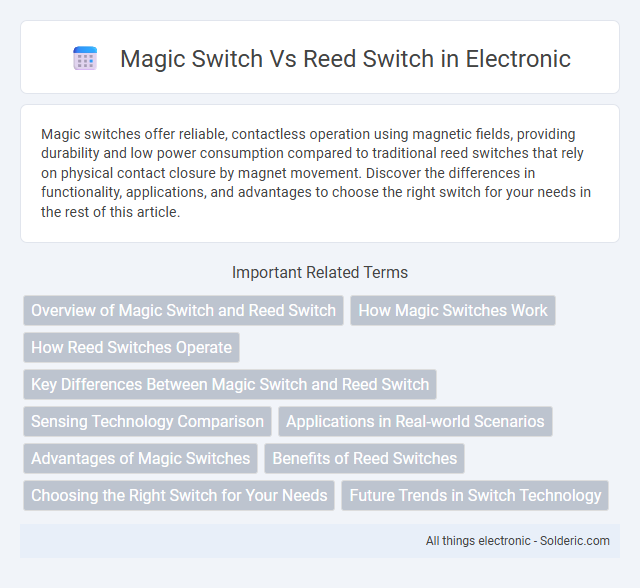Magic switches offer reliable, contactless operation using magnetic fields, providing durability and low power consumption compared to traditional reed switches that rely on physical contact closure by magnet movement. Discover the differences in functionality, applications, and advantages to choose the right switch for your needs in the rest of this article.
Comparison Table
| Feature | Magic Switch | Reed Switch |
|---|---|---|
| Operation | Touch or gesture-activated | Magnetically-operated contact switch |
| Contact Type | Electronic sensor, no physical contacts | Mechanical reed contacts inside a glass envelope |
| Durability | Highly durable, no mechanical wear | Limited by mechanical contact wear and glass fragility |
| Response Time | Instantaneous | Milliseconds |
| Power Consumption | Low, often requires power source | Passive, no power required |
| Applications | Smart home, gesture controls, modern electronics | Sensor switches, security systems, proximity detection |
| Sensitivity | High, can detect subtle gestures | Depends on magnetic field strength and distance |
| Environmental Resistance | Good, sealed electronic components | Vulnerable to shock, moisture through glass |
Overview of Magic Switch and Reed Switch
Magic switches utilize magnetic fields to activate or deactivate circuits without physical contact, offering enhanced durability and reliability in various electronic applications. Reed switches consist of two ferromagnetic blades sealed in a glass envelope that close or open an electrical circuit when exposed to a magnetic field, widely used for sensing and security systems. Both types provide effective magnetic actuation but differ in construction and specific use cases, with magic switches often favored for their non-mechanical interface.
How Magic Switches Work
Magic switches utilize magnetic fields to control electrical circuits by detecting changes in the field's presence or intensity, enabling seamless activation without physical contact. Unlike reed switches that rely on mechanical reeds closing under a magnetic influence, magic switches leverage Hall effect sensors or solid-state technology for faster, more reliable switching. Your application benefits from enhanced durability and reduced wear, as no moving parts are involved in magic switch operation.
How Reed Switches Operate
Reed switches operate through two thin, ferromagnetic blades sealed within a glass envelope that close or open an electrical circuit when exposed to a magnetic field. The magnetic field causes the reeds to magnetize, attract each other, and complete the circuit, providing a reliable and low-power switching mechanism ideal for sensing applications. Your choice depends on the application, as reed switches offer durable, contact-based switching sensitive to magnetic presence without requiring external power.
Key Differences Between Magic Switch and Reed Switch
Magic switches and reed switches differ primarily in their operation and application: magic switches use magnetic sensors to detect the presence of a magnetic field without physical contact, while reed switches rely on two ferromagnetic reeds that close or open an electrical circuit in response to a magnetic field. Reed switches are known for their simple mechanical design and reliable switching in low-power applications, whereas magic switches offer more durability due to the absence of moving parts. Your choice between these switches depends on factors like switching speed, contact wear, and environmental conditions, with magic switches typically preferred for maintenance-free, high-cycle applications.
Sensing Technology Comparison
Magic switches utilize Hall effect sensors to detect changes in magnetic fields, offering non-contact, highly accurate sensing ideal for applications requiring durability and minimal wear. Reed switches rely on mechanical contacts that close or open in response to a magnetic field, providing a simple and cost-effective solution but with limited lifespan due to physical contact wear. Your choice between these sensing technologies depends on factors like response time, environmental conditions, and longevity requirements in your application.
Applications in Real-world Scenarios
Magic switches excel in smart home automation systems, providing wireless control for lighting and appliances with minimal wiring. Reed switches are widely used in security systems, such as door and window sensors, offering reliable magnetic actuation for intrusion detection. Both switches serve industrial automation, with reed switches favored for precise position sensing and magic switches enabling remote operation in hazardous environments.
Advantages of Magic Switches
Magic switches offer enhanced sensitivity and faster response times compared to traditional reed switches, making them ideal for precision applications. Their sealed design ensures greater durability and resistance to environmental factors such as dust, moisture, and vibration. You benefit from reduced maintenance and increased reliability when integrating magic switches into your electronic or industrial systems.
Benefits of Reed Switches
Reed switches offer high reliability and long lifespan due to their hermetically sealed contacts, making them resistant to dust, moisture, and corrosive environments. They provide low power consumption and fast switching speeds, ideal for use in precision sensing applications such as security systems, automotive sensors, and consumer electronics. Reed switches also exhibit excellent sensitivity to magnetic fields, enabling accurate and stable operation with minimal maintenance.
Choosing the Right Switch for Your Needs
Selecting the right switch depends on your specific application requirements; a magic switch offers easy, contactless activation that increases durability and reduces wear, ideal for environments needing frequent, smooth operation. Reed switches provide a more traditional, magnetic-field-dependent operation with high reliability in low-power circuits, making them suitable for precise sensor tasks and simple on/off control. Understanding your device's sensitivity, response time, and environmental conditions will help you choose the most effective switch for your needs.
Future Trends in Switch Technology
Magic switches and reed switches are evolving rapidly with advances in smart home automation and IoT integration, emphasizing wireless connectivity and enhanced sensitivity. Future trends indicate a shift towards energy-efficient, long-lasting switches that support remote control and predictive maintenance through AI algorithms. Your choice of switch technology will increasingly depend on compatibility with smart systems and adaptability to emerging digital infrastructures.
Magic switch vs Reed switch Infographic

 solderic.com
solderic.com